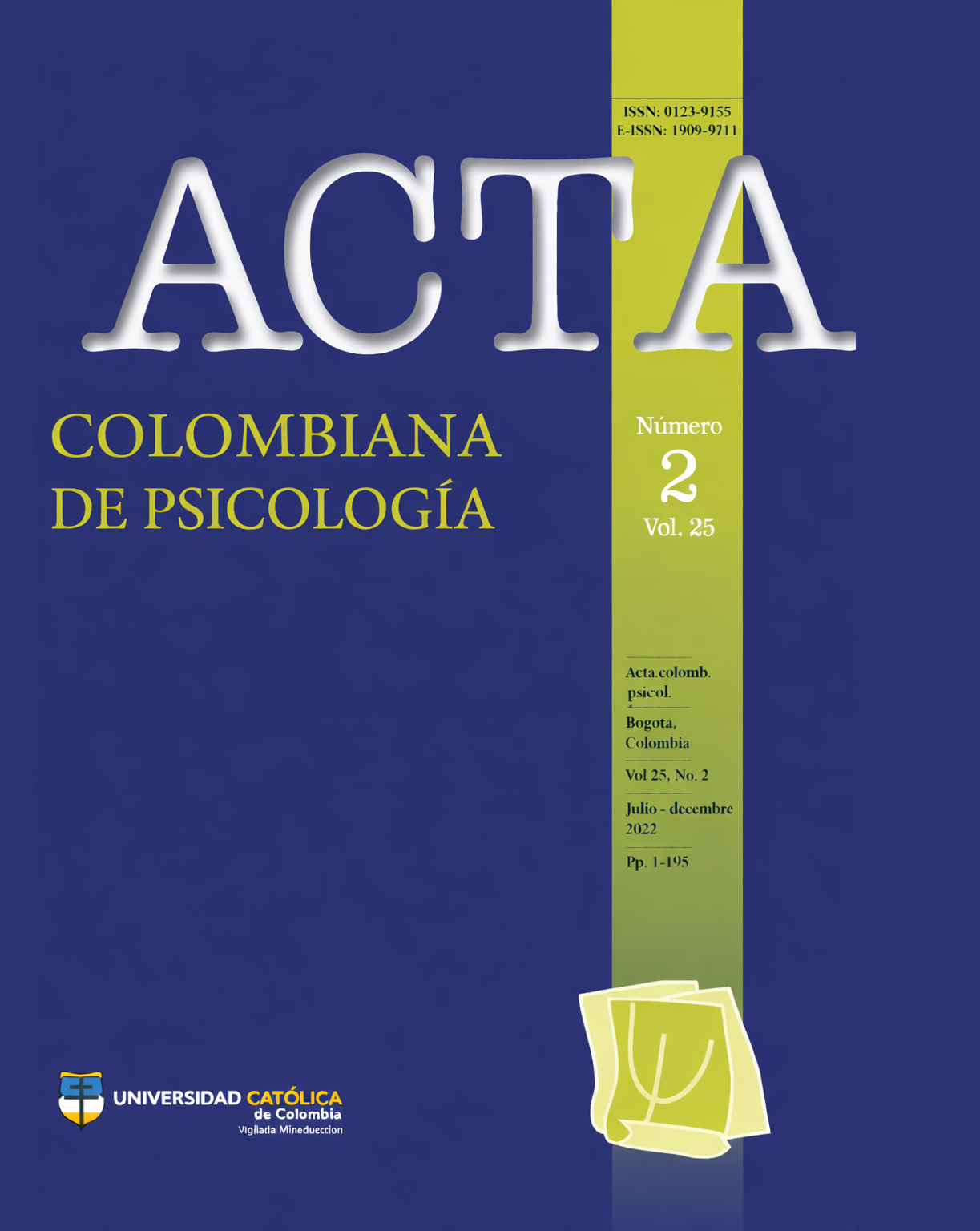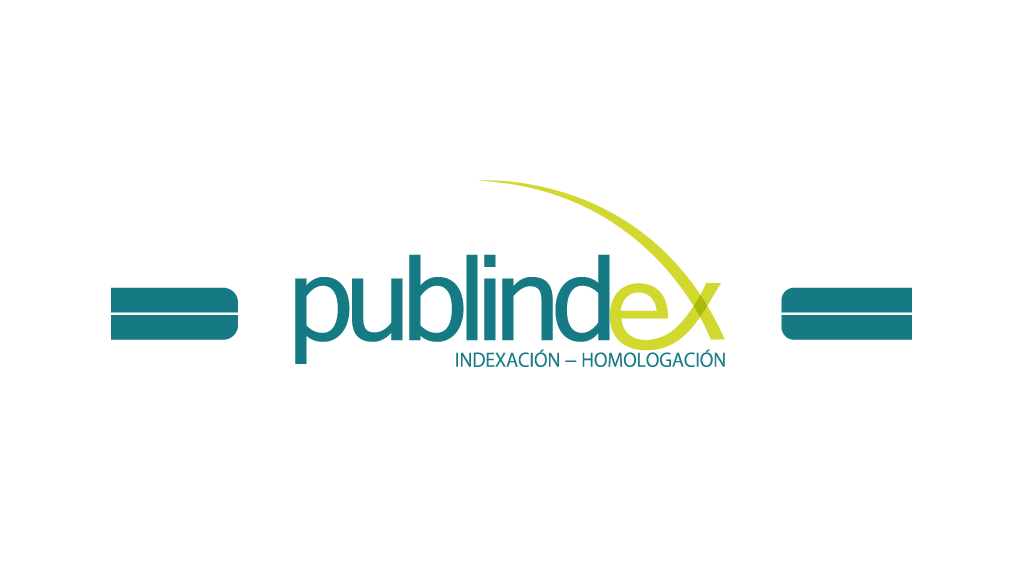
This work is licensed under a Creative Commons Attribution-NonCommercial-ShareAlike 4.0 International License.
Authors who publish in this journal agree to the following terms:
Acta Colombiana de Psicología complies with international intellectual property and copyright laws, and particularly with Article No. 58 of the Political Constitution of Colombia, Law No. 23 of 1982, and the Agreement No. 172 of September 30, 2010 (Universidad Católica de Colombia Intellectual Property Regulation).
Authors retain their copyright and grant to the Acta Colombiana de Psicología the right of first publication, with the work registered under Creative Commons attribution license, which allows third parties to use the published material, provided they credit the authorship of the work and the first publication in this Journal.
Abstract
The present study seeks to obtain validity and reliability evidence of the Parental Involvement Scale: Care and socialization activities in a sample of Peruvian parents of preschool children. For this purpose, the instrument was translated and linguistically harmonized from its English version into Spanish and then applied to a group of 420 fathers and 420 mothers of children from five cities. Evidence of the internal structure was evaluated through a multigroup confirmatory factor analysis, using the maximum likelihood method to examine the structure of the original 26 items. Items with low factor loadings were progressively eliminated until a model with adequate fit indicators was found [χ2 (531) = 822.82; p<0,001; χ2 / gl = 1.550; GFI = .90; CFI = .95; TLI = .94; RMSEA = .036, IC del 90% (.031 – .041), p close = 1.000, SRMR = .05]. The result was a18-items scale distributed in the five original dimensions, each with Cronbach’s alpha internal consistency reliability between .66 and .78 and Omega coefficients between .70 and .75. Inter-rater reliability was between .67 and .88. The scope and limitations of the study are discussed considering the relevance of having instruments to measure paternal involvement relative to maternal involvement , that consider the perspectives of fathers and mothers in the Peruvian context.

References
Adamsons, K. (2018). Quantity versus quality of nonresident father involvement: Deconstructing the argument that quantity doesn’t matter. Journal of Child Custody, 15(1), 26-34. https://doi.org/10.1080/15379418.2018.14 37002
Adamsons, K., & Johnson, S. K. (2013). An updated and expanded meta-analysis of nonresident fathering and child well-being. Journal of Family Psychology, 27(4), 589- 599. https://doi.org/10.1037/a0033786
Aguayo, F., Barker, G., & Kimelman, E. (2016). Editorial: Fatherhood and care in Latin America-absences, presences and transformations. Masculinities & Social Change, 5(2), 98-106. https://doi.org/10.17583/mcs.2016.2140
Amaral, R., Monteiro, L., & Santos, C. (2019). Perfis de envolvimento relativo do pai e ajustamento social de crianças em jardim-de-infância [Profiles of father ‘s relative involvement and children’s socio-emocional adjustment during preschool]. Análise Psicológica, 37(4), 463-477. https://doi.org/10.14417/ap.1553
Arrais, A. L., & Vieira-Santos, S. (2021). Envolvimento Paterno em Pais de Crianças em Idade Escolar: Relação com Estresse Parental, Apoio Social e Variáveis Sociodemográficas [Father Involvement in Parents of School-Aged Children: Relationship with Parenting Stress, Social Support and Sociodemographic Variables]. Psicologia: Teoria e Pesquisa, 37, Article e37313. https://doi.org/10.1590/0102.3772e37313
Ato, M., López, J., & Benavente, A. (2013). Un sistema de clasificación de los diseños de investigación en psicología. Anales de Psicología, 29(3), 1038-1059. https://doi.org/10.6018/analesps.29.3.178511
Banco Mundial (2021). Tasa de participación en la fuerza laboral, mujeres ( % de la población femenina entre 15- 64 años) (estimación modelado OIT). https://datos.ban comundial.org/indicator/SL.TLF.ACTI.FE.ZS
Barbeta-Viñas, M., & Cano, T. (2017). ¿Hacia un nuevo modelo de paternidad? Discursos sobre el proceso de implicación paterna en la España urbana. Revista Española de Investigaciones Sociológicas, 159, 13-30. https://doi. org/10.5477/cis/reis.159.13
Bentler, P. M. (1990). Comparative fit indexes in structural models. Psychological Bulletin, 107(2), 238-246. https:// doi.org/10.1037/0033-2909.107.2.238 Byrne, B. M. (2010). Structural equation modeling with AMOS: Basic concepts, applications, and programming (2. ª ed.). Routledge/Taylor & Francis Group.
Cabrera, N. J., Fitzgerald, H. E., Bradley, R. H., & Roggman, L. (2014). The ecology of father-child relationships: An expanded model. Journal of Family Theory & Review, 6(4), 336-354. https://doi.org/10.1111/jftr.12054
Cabrera, N. J., Volling, B. L., & Barr, R. (2018). Fathers are parents, too! Widening the lens on parenting for children’s development. Child Development Perspectives, 12(3), 152-157. https://doi.org/10.1111/cdep.12275
Charles, P., Spielfogel, J., Gorman-Smith, D., Schoeny, M., Henry, D., & Tolan, P. (2018). Disagreement in parental reports of father involvement. Journal of Family Issues, 39(2), 328-351. https://doi. org/10.1177/0192513X16644639
Craig, A. G., Thompson, J. M., Slykerman, R., Wall, C., Murphy, R., Mitchell, E. A., & Waldie, K. E. (2018). The long-term effects of early paternal presence on children’s behavior. Journal of Child and Family Studies, 27(11), 3544-3553. https://doi.org/10.1007/s10826-018-1206-1
Diniz, E., Brandão, T., Monteiro, L., & Veríssimo, M. (2021). Father involvement during early childhood: A systematic review of the literature. Journal of Family Theory & Review, 13, 77-99. https://doi.org/10.1111/jftr.12410
DiStefano, C., & Morgan, G. (2014). A comparison of diagonal weighted least squares robust estimation techniques for ordinal data. Structural Equation Modeling: A Multidisciplinary Journal, 21(3), 425-438. https://doi. org/10.1080/10705511.2014.915373
Doherty, W. J., Kouneski, E. F., & Erickson, M. F. (1998). Responsible fathering: An overview and conceptual framework. Journal of Marriage and the Family, 60(2), 277-292. https://doi.org/10.2307/353848
Escribano, S., Aniorte, J., & Orgilés, M. (2013). Factor structure and psychometric properties of the Spanish version of the Alabama Parenting Questionnaire (APQ) for children. Psicothema, 25(3), 324-329. https://doi. org/10.7334/psicothema2012.315
Field, A. (2013). Discovering statistics using IBM SPSS Statistics (and sex, and drugs and rock ´n´ roll) (4. ª ed.). Sage.
Garfield, C. F., Fisher, S. D., Barretto, D., Rutsohn, J., & Isacco, A. (2019). Development and validation of a father’s involvement in health measures. Psychology of Men & Masculinities, 20(1), 148-160. https://doi. org/10.1037/men0000144
Guerrero Nancuante, C. I., Armstrong Barea, L., González Adonis, F., Bratz, J., & Sandoval Ramírez, M. (2020). Paternidad activa y cuidado en la niñez: Reflexiones desde las desigualdades de género y la masculinidad. Enfermería Actual de Costa Rica, 38, 282-291. https:// doi.org/10.15517/revenf.v0i38.34163
Gusi, N., Badía, X., Herdman, M., & Olivares, P. R. (2009). Traducción y adaptación cultural de la versión española del cuestionario EQ-5D-Y en niños y adolescentes. Atención Primaria, 41(1), 19-23. https://doi. org/10.1016/j.aprim.2008.04.005
Hawkins, A. J., Bradford, K. P., Palkovitz, R., Christiansen, S. L., Day, R. D., & Call, V. R. (2002). The inventory of father involvement: A pilot study of a new measure of father involvement. The Journal of Men’s Studies, 10(2), 183-196. https://doi.org/10.3149/jms.1002.183
Hernandez, D. C., & Coley, R. L. (2007). Measuring father involvement within low-income families: Who is a reliable and valid reporter? Parenting: Science and Practice, 7(1), 69-97. https://doi.org/10.1080/15295190709336777
Hohmann-Marriott, B. (2011). Coparenting and father involvement in married and unmarried coresident couples. Journal of Marriage and Family, 73(1), 296-309. https:// doi.org/10.1111/j.1741-3737.2010.00805.x
Hooper, D., Coughlan, J., & Mullen, M. (2008). Structural Equation Modeling: Guidelines for determining model fit. Electronic Journal of Business Research Methods, 6(1), 53-60. https://doi.org/10.21427/D7CF7R
Hu, L., & Bentler, P. M. (1999). Cutoff criteria for fit indexes in covariance structure analysis: Conventional criteria versus new alternatives. Structural Equation Modeling: A Multidisciplinary Journal, 6(1), 1-55. http://doi. org/10.1080/10705519909540118
International Planned Parenthood Federation/Western Hemisphere Region [ippf/whr] & Promundo (2017). Estado de la paternidad: América Latina y el Caribe. ippf/rho y Promundo-US. https://promundoglobal. org/wp-content/uploads/2017/06/2017-
Informe-Esta do-de-la-Paternidad-LAC.pdf Izquierdo, L., & Zicavo, N. (2015). Nuevos padres: Construcción del rol paternal en hombres que participan activamente en la crianza de los hijos. Revista de Investigación en Psicología, 18(2), 33-55. https://doi. org/10.15381/rinvp.v18i2.12082
Jia, R., & Schoppe-Sullivan, S. J. (2011). Relations between coparenting and father involvement in families with preschool aged children. Developmental Psychology, 47(1), 106-118. http://doi.org/10.1037/a0020802
Kline, R. B. (2015). Principles and practice of structural equation modeling (4. ª ed.). Guilford Publications.
Kotila, L. E., Schoppe-Sullivan, S. J., & Kamp Dush, C. M. (2013). Time in parenting activities in dual-earner families at the transition to parenthood. Family Relations, 62(5), 795-807. https://doi.org/10.1111/fare.12037
Lamb, M. E. (1987). The emergent American father. En M. E. Lamb (Ed.), The father’s role: Crosscultural perspectives (pp. 3-25). Lawrence Erlbaum Associates, Inc.
Lamb, M. E., & Tamis-Lemonda, C. S. (2004). The role of the father: An introduction. En M. E. Lamb (Ed.), The role of the father in child development (4. ª ed.) (pp. 1-31).
John Wiley & Sons. Li, Ch. (2016). The performance of ML, DWLS, and ULS estimation with robust corrections in structural equation models with ordinal variables. Psychological Methods, 21(3), 369-387. https://doi.org/10.1037/met0000093
Maroto-Navarro, G., Ocaña-Riola, R., Gil-García, E., & García-Calvente, M. D. M. (2020). Análisis multinivel de la producción científica mundial sobre paternidad, desarrollo humano e igualdad de género. Gaceta Sanitaria, 34(6), 582-588. https://doi.org/10.1016/j. gaceta.2019.04.008
McBride, B. A., Schoppe, S. J., Ho, M., & Rane T. R. (2004). Multiple determinants of father involvement: An exploratory analysis using the PSID-CDS data set. En R. D. Day & M. E. Lamb (Eds.), Conceptualizing and measuring father involvement (pp. 321-340). Lawrence Erlbaum Associates Publishers.
Mîndrilă, D. (2010). Maximum Likelihood (ML) and Diagonally Weighted Least Squares (DWLS) estimation procedures: A Comparison of estimation bias with ordinal and multivariate non-normal data. International Journal of Digital Society, 1(1), 60-66. https://doi.org/10.20533/ ijds.2040.2570.2010.0010
Monteiro, L., Fernandes, M., Torres, N., & Santos, C. (2017). Father’s involvement and parenting styles in Portuguese families: The role of education and working hours. Análise Psicológica, 35(4), 513-528. https://doi. org/10.14417/ap.1451
Monteiro, L., Fernandes, M., Veríssimo, M., Pessoa e Costa, I. P., Torres, N., & Vaughn, B. E. (2010). Perspectiva do pai acerca do seu envolvimento em famílias nucleares. Associações com o que é desejado pela mãe e com as características da criança [Father ‘s perception about their involvement in bi-parental families. Associations with what mothers want and children ‘s characteristics]. Revista Interamericana de Psicología, 44(1), 120-130. https://www.redalyc.org/articulo.oa?id=28420640013
Monteiro, L., Torres, N., & Salinas-Quiroz, F. (2019). Preditores do envolvimento paterno numa amostra de famílias portuguesas. O papel das crenças parentais. Suma Psicológica, 26(2), 94-102. https://doi.org/10.14349/su mapsi.2019.v26.n2.5
Monteiro, L., Veríssimo, M., & Pessoa e Costa, I. (2008). Escala de envolvimento parental: Actividades de cuidados e de socialização [Parental Involvement: Care and Socialization Activities]. Unpublished Manual. ISPAInstituto Universitário.
Muñiz, J., Elosua, P., & Hambleton, R. (2013). Directrices para la traducción y adaptación de los tests: Segunda edición. Psicothema, 25(2), 151-157. https://doi. org/10.7334/psicothema2013.24
Nunnally, J., & Bernstein, I. (1994). Psychometric theory. McGraw Hill.
Palkovitz, R. (1997). Reconstructing ‘‘involvement’’: Expanding conceptualizations of men’s caring in contemporary families. En A. J. Hawkins & D.C. Dollahite (Eds.), Generative fathering: Beyond deficit perspectives (pp. 200-216). Sage Publications, Inc.
Pasley, K., & Braver, S. L. (2004). Measuring father involvement in divorced, nonresidential fathers. En R. D. Day & M. E. Lamb (Eds.), Conceptualizing and measuring father involvement (pp. 217-240). Lawrence Erlbaum Associates, Inc.
Pimenta, M., Veríssimo, M., Monteiro, L., & Pessoa e Costa, I. (2010). O envolvimento paterno de crianças a frequentar o jardim-de-infância. Análise Psicológica, 28(4), 565-580. https://doi.org/10.14417/ap.375
Piskernik, B., & Ahnert, L. (2019). What does it mean when fathers are involved in parenting? En B. L. Volling & N. J. Cabrera (Eds.), Advancing research and measurement on fathering and children’s development. Monographs of the Society of Research in Child Development, 84(1), 64- 78. https://doi.org/10.1111/mono.12404
Pleck, J. H. (2007). Why could father involvement benefit children? Theoretical perspectives. Applied Development Science, 11(4), 196-202. https://doi. org/10.1080/10888690701762068
Pleck, J. H. (2010). Paternal involvement: Revised conceptualization and theoretical linkages with child outcomes. En M. E. Lamb (Ed.), The Role of the Father in Child Development (5. ª ed.) (pp. 58-93). John Wiley & Sons.
Pleck, J. H. (2012). Integrating father involvement in parenting research. Parenting: Science and Practice, 12(2-3), 243-253. https://doi.org/10.1080/15295192.2012.683365
Pontificia Universidad Católica del Perú (2011). Reglamento del Comité de Ética para la investigación con seres humanos y animales de la Pontificia Universidad Católica del Perú. http://textos.pucp.edu.pe/pdf/1250.pdf
Radin, N. (1994). Primary-caregiving fathers in intact families. En A. E. Gottfried & A. W. Gottfried (Eds.), Redefining families: Implications for children’s development (pp. 11-54). Plenum Press. https://doi. org/10.1007/978-1-4899-0961-9_2
Rico, M. N., & Robles, C. (2016). Políticas de cuidado en América Latina: Forjando la igualdad. CEPAL-Serie de Asuntos de Género, 140. Naciones Unidas. http:// repositorio.cepal.org/bitstream/handle/11362/40628/1/ S1600887_es.pdf
Robitzsch, A. (2020). Why ordinal variables can (almost) always be treated as continuous variables: Clarifying assumptions of robust continuous and ordinal factor analysis estimation methods. Frontiers in Education, 5, Article 589965. https://doi.org/10.3389/feduc.2020.589965
Santis, L. D., & Barham, E. J. (2017). Envolvimento Paterno: Construção de um Modelo Teórico Baseado em uma Revisão da Literatura [Father involvement: Construction of a theoretical model based on a literature review]. Temas em Psicologia, 25(3), 941-953. https:// doi.org/10.9788/tp2017.3-03pt
Schoppe-Sullivan, S. J., & Fagan, J. (2020). The evolution of fathering research in the 21st century: Persistent challenges, new directions. Journal of Marriage and Family, 82(1), 175-197. https://doi.org/10.1111/jomf.12645
Schreiber, J., Nora, A., Stage, F., Barlow, E., & King, J. (2006). Reporting structural equation modeling and confirmatory factor analysis results: A review. The Journal of Educational Research, 99(6), 323-338. https://doi. org/10.3200/JOER.99.6.323-338
Slaughter, J., & Nagoshi, C. T. (2020). Testing a contextual model of effects of father involvement on child behaviors. Child and Adolescent Social Work Journal, 37(5), 547-556. https://doi.org/10.1007/s10560-020-00649-5
Tagliabue, S., Olivari, M.G., Bacchini, D., Affuso, G., & Confalonieri, E. (2014). Measuring adolescents’ perceptions of parenting style during childhood: Psychometric properties of the parenting styles and dimensions questionnaire. Psicologia: Teoria e Pesquisa, 30(3), 251-258. https://doi.org/10.1590/S0102-37722014000300002
Torres, N., Veríssimo, M., Monteiro, L., Ribeiro, O., & Santos, A. J. (2014). Domains of father involvement, social competence and problem behavior in preschool children. Journal of Family Studies, 20(3), 188-203. https:// doi.org/10.1080/13229400.2014.11082006
Torres, N., Veríssimo, M., Monteiro, L., Santos, A. J., & Pessoa e Costa, I. (2012). Father involvement and peer play competence in preschoolers: The moderating effect of the child’s difficult temperament. Family Science, 3(3-4), 174-188. https://doi.org/10.1080/19424620.2012.783426
Trahan, M. H., & Cheung, M. (2016). Testing gender applicability of father involvement instruments. Social Work Research, 40(4), 203-211. https://doi.org/10.1093/swr/ svw014
Ventura-León, J., & Caycho-Rodríguez, T. (2017). El coeficiente Omega: Un método alternativo para la estimación de la confiabilidad. Revista Latinoamericana de Ciencias Sociales, Niñez y Juventud, 15(1), 625-627. http://revistalatinoamericanaumanizales.cinde.org.co/ docs/Abril2021/Cartas%20al%20Editor.%20El%20coe ficiente%20Omega.pdf
Volling, B. L., & Cabrera, N. J. (2019). Advancing research and measurement on fathering and child development: Introducing the issues and a conceptual framework. En B.L. Volling & N. J. Cabrera (Eds.), Advancing research and measurement on fathering and children’s development. Monographs of the Society of Research in Child Development, 84(1), 7-17. https://doi.org/10.1111/ mono.12404
































